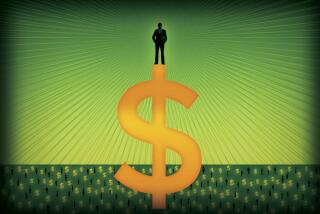Nearly Forgotten, Dividends Are Coming Back
Corporate America is getting more generous with cash dividends, and just in time.
With the stock market churning and making no progress in 1994, capital gains are but a memory for most investors. That leaves dividend income as stock owners’ only hope for some kind of return.
The good news is that there were 1,333 dividend increases by American companies between Jan. 1 and Sept. 30, the most for that period since 1981, according to Standard & Poor’s Corp.
Yet corporate managers arguably have a lot of catching up to do in sharing the wealth with stockholders: The average dividend yield on the blue-chip S&P; 500 stocks is a mere 2.9%, near its historical low and far below the yields on competing investments. Even boring six-month U.S. Treasury bills yield 5.5% today.
Stocks’ generally low yields aren’t a new phenomenon, of course. As interest rates have declined over the past 13 years, stock prices have rocketed. That’s been a natural yield-depressant. And when corporate earnings stalled with the 1990-’91 recession, so did dividend increases.
In fact, the typical stock yield has been so low for so long that some Wall Streeters question whether dividends matter much anymore. Rather than pay cash to shareholders--a fully taxable event--many firms now resort to share buybacks to boost their stocks and thus generate bigger capital gains for investors, taxable at lower rates.
Some market pros, however, argue that the importance of dividends has merely been obscured over the past decade by stocks’ oversized price gains. If it gets ever more difficult to pick winning stocks in the 1990s--and that has certainly been true since ‘92--dividend income will be very meaningful again, these pros contend.
One dividend proponent is John Fields, manager of the Philadelphia-based Delaware Group’s Decatur Total Return and Decatur Income stock funds. He notes that the S&P; 500 index’s average annual gain from price appreciation in the wild 1980s was 12.6%, the best showing since the 1950s. Dividends added another 4.4% a year to that ‘80s return, but who cared at that point?
Now look at S&P; returns in the 1990-1993 period, Fields says. The annualized capital gain dropped to 7.2%, while dividends added 3.5% a year--providing one-third of stocks’ “total” return in the period. And measured from 1926 through 1993, dividends’ importance to the S&P;’s total return is even greater: You earned 10.3% a year, of which fully 4.9% was from dividends.
Fields’ point is that, if stock market returns are coming back into line with historical averages, dividend income could mean the difference between relative success and failure in investing. His kind of mature, high-dividend stocks--Exxon, W. R. Grace, J. C. Penney, GE, among many others--make sense as “core” holdings, offering greater stability than pure “growth” stocks in dicey markets, plus some inflation protection in the form of rising dividends, Fields says.
Put another way, a dividend is a cushion, and cushions may have more value in difficult markets.
The Decatur Total Return fund currently yields about 3% from dividends, while the Decatur Income fund yields about 4% (the latter fund includes some bonds, to boost the yield). Some of Fields’ competitor funds yield even more. Lindner Dividend fund’s yield, for example, tops 7%; the Evergreen Total Return fund yields 5.9%.
But you have to be careful about what you’re buying in a fund that emphasizes dividends. Funds heavily invested in electric utilities, for example, have been slammed this year as that industry’s outlook has soured. And very-high-yielding stocks often are in danger of dividend cuts.
Moreover, while dividends obviously have been important in historical stock returns, San Diego-based pension consultant Michael Stolper notes that the best stock funds to own are those managed by good stock-pickers, period. Dividend income, after all, is limited. Capital gains aren’t.
Consider: Over the past 30 years, the average “equity-income” fund (the category in which most dividend funds fall) has gained an impressive 2,041%, according to Lipper Analytical. The average “growth” fund did far better, up 2,723%. The question, as always, is how much risk you’re willing to accept on the way to potentially higher returns. Dividends may let you sleep better.
Better Dividends
After three years of paltry increases, total dividends paid by the Standard & Poor’s 500-index companies are expected to rise nearly 3% this year from 1993, as managements share more earnings with stockholders.
S&P; 500 dividend increases (in %)
1994*: +2.7%
* Estimate
Source: Standard & Poor’s Corp.
More to Read
Inside the business of entertainment
The Wide Shot brings you news, analysis and insights on everything from streaming wars to production — and what it all means for the future.
You may occasionally receive promotional content from the Los Angeles Times.










